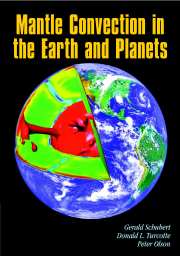Book contents
- Frontmatter
- Contents
- Preface
- 1 Historical Background
- 2 Plate Tectonics
- 3 Structure and Composition of the Mantle
- 4 Mantle Temperatures and Thermodynamic Properties
- 5 Viscosity of the Mantle
- 6 Basic Equations
- 7 Linear Stability
- 8 Approximate Solutions
- 9 Calculations of Convection in Two Dimensions
- 10 Numerical Models of Three-dimensional Convection
- 11 Hot Spots and Mantle Plumes
- 12 Chemical Geodynamics
- 13 Thermal History of the Earth
- 14 Convection in the Interiors of Solid Planets and Moons
- 15 Nature of Convection in the Mantle
- References
- Appendix: Table of Variables
- Author Index
- Subject Index
13 - Thermal History of the Earth
Published online by Cambridge University Press: 15 December 2009
- Frontmatter
- Contents
- Preface
- 1 Historical Background
- 2 Plate Tectonics
- 3 Structure and Composition of the Mantle
- 4 Mantle Temperatures and Thermodynamic Properties
- 5 Viscosity of the Mantle
- 6 Basic Equations
- 7 Linear Stability
- 8 Approximate Solutions
- 9 Calculations of Convection in Two Dimensions
- 10 Numerical Models of Three-dimensional Convection
- 11 Hot Spots and Mantle Plumes
- 12 Chemical Geodynamics
- 13 Thermal History of the Earth
- 14 Convection in the Interiors of Solid Planets and Moons
- 15 Nature of Convection in the Mantle
- References
- Appendix: Table of Variables
- Author Index
- Subject Index
Summary
Introduction
Mantle convection plays an essential role in determining the evolution of the Earth's temperature through geologic time because it is the primary mechanism by which the Earth transfers heat from its deep interior to its surface. Once the internally generated heat reaches the surface it is transferred to the ocean–atmosphere system by a variety of processes including conduction and hydrothermal circulation through the oceanic crust and is eventually radiated to space. From the perspective of studying the changes in the Earth's interior temperature over geologic time, we can ignore the relatively rapid transport of internal heat through the atmosphere and oceans and assume that all heat delivered to the Earth's surface from below immediately escapes the Earth. The heat lost through the Earth's surface tends to cool the interior, and heat produced within the Earth by the decay of radioactive elements tends to warm it. The thermal evolution of the Earth is a consequence of the competition between internal energy sources producing heat and mantle convection removing it. A quantitative description of the Earth's thermal history is the application of basic energy conservation in a convecting mantle.
While the basic approach to modeling the Earth's thermal history is straightforward, its implementation is a major challenge because of the complexity of a realistic model and available computer resources that limit detailed numerical calculations of three-dimensional, time-dependent convection at the very high Rayleigh numbers applicable to the Earth's present mantle and at the even higher Rayleigh numbers appropriate to the Earth's early mantle.
- Type
- Chapter
- Information
- Mantle Convection in the Earth and Planets , pp. 586 - 632Publisher: Cambridge University PressPrint publication year: 2001



